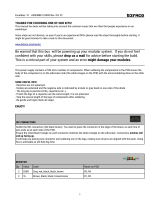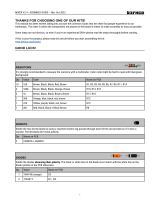Renesas ISL8215MEVAL2Z Operating instructions
- Type
- Operating instructions
Renesas ISL8215MEVAL2Z is a highly efficient power module evaluation board featuring the ISL8215M, a single-channel synchronous step-down power supply. It delivers up to 15 amps of continuous current, making it ideal for high-power density applications. With an adjustable output voltage from 0.6V to 12V and efficiencies of up to 96.5%, the ISL8215MEVAL2Z is an excellent choice for powering various electronic devices.
Key features of the ISL8215MEVAL2Z:
- Wide input voltage range: 7V to 42V
- Adjustable output voltage: 0.6V to 12V
- High efficiency: up to 96.5%
- High light-load efficiency with pulse skipping DEM operation
Renesas ISL8215MEVAL2Z is a highly efficient power module evaluation board featuring the ISL8215M, a single-channel synchronous step-down power supply. It delivers up to 15 amps of continuous current, making it ideal for high-power density applications. With an adjustable output voltage from 0.6V to 12V and efficiencies of up to 96.5%, the ISL8215MEVAL2Z is an excellent choice for powering various electronic devices.
Key features of the ISL8215MEVAL2Z:
- Wide input voltage range: 7V to 42V
- Adjustable output voltage: 0.6V to 12V
- High efficiency: up to 96.5%
- High light-load efficiency with pulse skipping DEM operation













-
 1
1
-
 2
2
-
 3
3
-
 4
4
-
 5
5
-
 6
6
-
 7
7
-
 8
8
-
 9
9
-
 10
10
-
 11
11
-
 12
12
-
 13
13
Renesas ISL8215MEVAL2Z Operating instructions
- Type
- Operating instructions
Renesas ISL8215MEVAL2Z is a highly efficient power module evaluation board featuring the ISL8215M, a single-channel synchronous step-down power supply. It delivers up to 15 amps of continuous current, making it ideal for high-power density applications. With an adjustable output voltage from 0.6V to 12V and efficiencies of up to 96.5%, the ISL8215MEVAL2Z is an excellent choice for powering various electronic devices.
Key features of the ISL8215MEVAL2Z:
- Wide input voltage range: 7V to 42V
- Adjustable output voltage: 0.6V to 12V
- High efficiency: up to 96.5%
- High light-load efficiency with pulse skipping DEM operation
Ask a question and I''ll find the answer in the document
Finding information in a document is now easier with AI
Related papers
-
Renesas RTKA2108252H00000BU Operating instructions
-
Renesas RTKA2108702H00000BU Operating instructions
-
Renesas lSL8273MEVAL1Z User manual
-
Renesas ISL8282MEVAL1Z Operating instructions
-
Renesas ISL8280MEVAL1Z Operating instructions
-
Renesas ISL85009EVAL1Z Operating instructions
-
Renesas ISL8117AEVAL1Z User manual
-
Renesas ISL8033DEMO1Z User manual
-
Renesas ISL78234EVAL2Z User manual
-
Renesas ISL81401EVAL1Z Operating instructions
Other documents
-
 Befaco EXCALIBUS Assembly Instructions
Befaco EXCALIBUS Assembly Instructions
-
 Befaco Mixer Assembly Instructions
Befaco Mixer Assembly Instructions
-
 Befaco Slew Limiter Assembly Instructions
Befaco Slew Limiter Assembly Instructions
-
Analog Devices LTC3312SA Operating instructions
-
Analog Devices DC3092A User manual
-
Linear Technology DC1700A Demo Manual
-
Datel USQ-5/20-D24 User manual
-
Linear Technology DC2111A-A/B Demo Manual
-
Cosel BRDS150 User manual
-
onsemi NCV12711 User manual















